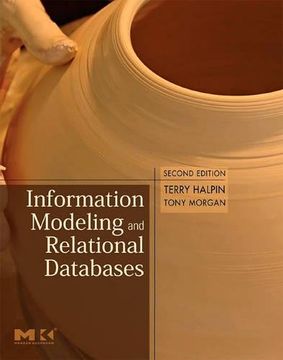Information Modeling and Relational Databases: From Conceptual Analysis to Logical Design (The Morgan Kaufmann Series in Data Management Systems) (en Inglés)
Reseña del libro "Information Modeling and Relational Databases: From Conceptual Analysis to Logical Design (The Morgan Kaufmann Series in Data Management Systems) (en Inglés)"
Information Modeling and Relational Databases, second edition, provides an introduction to ORM (Object-Role Modeling)and much more. In fact, it is the only book to go beyond introductory coverage and provide all of the in-depth instruction you need to transform knowledge from domain experts into a sound database design. This book is intended for anyone with a stake in the accuracy and efficacy of databases: systems analysts, information modelers, database designers and administrators, and programmers.Terry Halpin, a pioneer in the development of ORM, blends conceptual information with practical instruction that will let you begin using ORM effectively as soon as possible. Supported by examples, exercises, and useful background information, his step-by-step approach teaches you to develop a natural-language-based ORM model, and then, where needed, abstract ER and UML models from it. This book will quickly make you proficient in the modeling technique that is proving vital to the development of accurate and efficient databases that best meet real business objectives.*Presents the most indepth coverage of Object-Role Modeling available anywhere, including a thorough update of the book for ORM2, as well as UML2 and E-R (Entity-Relationship) modeling.*Includes clear coverage of relational database concepts, and the latest developments in SQL and XML, including a new chapter on the impact of XML on information modeling, exchange and transformation.* New and improved case studies and exercises are provided for many topics.* The book's associated web site provides answers to exercises, appendices, advanced SQL queries, and links to downloadable ORM tools.1 Introduction1.1 Information Modeling1.2 Modeling Approaches1.3 Some Historical Background1.4 The Relevant Skills1.5 Summary2 Information Levels and Frameworks2.1 Four Information Levels2.2 The Conceptual Level2.3 Database Design Example2.4 Development Frameworks2.5 Summary3 Conceptual Modeling: First Steps3.1 Conceptual Modeling Language Criteria3.2 Conceptual Schema Design Procedure3.3 CSDP Step 1: From Examples to Elementary Facts3.4 CSDP Step 2: Draw Fact Types, and Populate3.5 CSDP Step 3: Trim Schema; Note Basic Derivations3.6 Summary4 Uniqueness Constraints4.1 CSDP Step 4: Uniqueness Constraints; Arity Check4.2 Uniqueness Constraints on Unaries and Binaries4.3 Uniqueness Constraints on Longer Fact Types4.4 External Uniqueness Constraints4.5 Key Length Check4.6 Projections and Joins4.7 Summary5 Mandatory Roles5.1 Introduction to CSDP Step 55.2 Mandatory and Optional Roles5.3 Reference Schemes5.4 Case Study: A Compact Disc Retailer5.5 Logical Derivation Check5.6 Summary6 Value, Set-Comparison and Subtype Constraints6.1 CSDP Step 6: Value, Set-Comparison and Subtype constraints6.2 Basic Set Theory6.3 Value Constraints and Independent Objects6.4 Subset, Equality, and Exclusion Constraints6.5 Subtyping6.6 Generalization of Object Types6.7 Summary7 Other Constraints and Final Checks7.1 CSDP Step 7: Other Constraints and Final Checks7.2 Occurrence Frequencies7.3 Ring Constraints7.4 Other Constraints and Rules7.5 Final Checks7.6 Summary8 Entity Relationship Modeling8.1 Overview of ER8.2 Barker notation8.3 Information Engineering notation8.4 IDEF1X8.5 Mapping from ORM to ER8.6 Summary9 Data Modeling in UML9.1 Introduction9.2 Object-Orientation9.3 Attributes9.4 Associations9.5 Set-Comparison constraints9.6 Subtyping9.7 Other Constraints and Derivation Rules9.8 Mapping from ORM to UML9.9 Summary10 Advanced Modeling Issues10.1 Join Constraints10.2 Deontic Rules10.3 Temporality10.4 Collection Types10.5 Nominalization and Objectification10.6 Open/Closed World Semantics10.7 Higher-Order Types10.8 Summary11 Relational Mapping11.1 Implementing a Conceptual Schema11.2 Relational Schemas11.3 Relational Mapping Procedure11.4 Advanced Mapping Aspects11.5 Summary12 Data Manipulation with Relational Languages12.1 Relational Algebra12.2 Relational Database Systems12.3 SQL: Historical and Structural Overview12.4 SQL: Identifiers and Data Types12.5 SQL: Choosing Columns, Rows, and Order12.6 SQL: Joins12.7 SQL: In, Between, Like, and Null Operators12.8 SQL: Union and Simple Subqueries12.9 SQL: Scalar Operators and Bag Functions12.10 SQL: Grouping12.11 SQL: Correlated and Existential Subqueries12.12 SQL: Recursive Queries12.13 SQL: Updating Table Populations12.14 SQL: Other Useful Constructs12.15 Summary13 Using Other Database Objects13.1 SQL: Data Definition13.2 SQL: User Defined Functions13.3 SQL: Views and Computed Columns13.4 SQL: Triggers13.5 SQL: Stored Procedures13.6 SQL: Indexes13.7 Other Objects13.8 Exploiting 3GLs13.9 Exploiting XML13.10 Security and Meta-Data13.11 Concurrency13.12 Summary14 Schema Transformations14.1 Schema Equivalence and Optimization14.2 Predicate Specialization and Generalization14.3 Nesting, Coreferencing, and Flattening14.4 Other Transformations14.5 Conceptual Schema Optimization14.6 Normalization14.7 Denormalization and Low Level Optimization14.8 Reengineering14.9 Data Migration and Query Transformation14.10 Summary15 Process and State Modeling15.1 Introduction15.2 Processes and Workflow15.3 Foundations for Process Theory15.4 State Models versus Process Models15.5 Modeling Information Dynamics in UML15.6 Standard Process Patterns15.7 Business Process Standards Initiatives15.8 Integration of Process Models and Information Models15.9 Summary16 Other Modeling Aspects and Trends16.1 Introduction16.2 Data Warehousing and OLAP16.3 Conceptual Query Languages16.4 Schema Abstraction Mechanisms16.5 Further Design Aspects16.6 Ontologies and the Semantic Web16.7 Post-Relational Databases16.8 Metamodeling16.9 SummaryORM glossary (ORM 1 and ORM 2)ER glossaryUML glossaryBibliographyIndex

